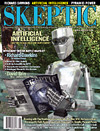There is rich irony in how the present battle over Creationism v. Darwinism has taken shape, and especially the ways that this round differs from previous episodes. A clue to both the recent success — and the eventual collapse — of “Intelligent Design” can be found in its name, and in the new tactics that are being used to support its incorporation into school curricula. In what must be taken as sincere flattery, these tactics appear to acknowledge just how deeply the inner lessons of science have pervaded modern culture.
Intelligent Design (ID) pays tribute to its rival, by demanding to be recognized as a direct and “scientific” competitor with the Theory of Evolution. Unlike the Creationists of 20 years ago, proponents of ID no longer refer to biblical passages. Instead, they invoke skepticism and cite alleged faulty evidence as reasons to teach students alternatives to evolution.
True, they produce little or no evidence to support their own position. ID promoters barely try to undermine evolution as a vast and sophisticated model of the world, supported by millions of tested and interlocking facts. At the level that they are fighting, none of that matters. Their target is the millions of onlookers and voters, for whom the battle is as emotional and symbolic as it ever was.
What has changed is the armory of symbols and ideas being used. Proponents of Intelligent Design now appeal to notions that are far more a part of the lexicon of science than religion, notably openness to criticism, fair play, and respect for the contingent nature of truth.
These concepts proved successful in helping our civilization to thrive, not only in science, but markets, democracy and a myriad other modern processes. Indeed, they have been incorporated into the moral foundations held by average citizens, of all parties and creeds. Hence, the New Creationists have adapted and learned to base their arguments upon these same principles. One might paraphrase the new position, that has been expressed by President Bush and many others, as follows:
What do evolutionists have to fear? Are they so worried about competition and criticism that they must censor what bright students are allowed to hear? Let all sides present their evidence and students will decide for themselves!
One has to appreciate not only irony, but an implied tribute to the scientific enlightenment, when we realize that openness to criticism, fair play, and respect for the contingent nature of truth are now the main justifications set forward by those who still do not fully accept science. Some of those promoting a fundamentalist- religious agenda now appeal to principles they once fiercely resisted. (In fairness, some religions helped to promote these concepts.) Perhaps they find it a tactically useful maneuver.
It’s an impressive one. And it has allowed them to steal a march. While scientists and their supporters try to fight back with judicious reasoning and mountains of evidence, a certain fraction of the population perceives only smug professors, fighting to protect their turf — authority figures trying to squelch brave underdogs before they can compete. Image matters. And this self-portrayal — as champions of open debate, standing up to stodgy authorities — has worked well for the proponents of Intelligent Design (ID). For now.
Yet, I believe they have made a mistake. By basing their offensive on core notions of fair play and completeness, ID promoters have employed a clever short-term tactic, but have incurred a long-term strategic liability. Because, their grand conceptual error is in believing that their incantation of Intelligent Design is the only alternative to Darwinian evolution.
If students deserve to weigh ID against natural selection, then why not also expose them to…
1. Guided Evolution
This is the deist compromise most commonly held by thousands — possibly millions — of working scientists who want to reconcile science and faith. Yes, the Earth is 4.6 billion years old and our earliest ancestors emerged from a stew of amino acids that also led to crabs, monkeys and slime molds who are all distant relatives. Still, a creative force may have been behind the Big Bang, and especially the selection of some finely tuned physical constants, whose narrow balance appears to make the evolution of life possible, maybe even inevitable. Likewise, such a force may have given frequent or occasional nudges of subtle guidance to evolution, all along, as part of a Divine Plan.
There is one advantage — and drawback — to this notion (depending on your perspective): it is compatible with everything we see around us — all the evidence we’ve accumulated — and it is utterly impossible to prove or disprove. Not only does this let many scientists continue both to pray and do research, but it has allowed the Catholic Church and many other religious organizations to accept (at long last) evolution as fact, with relatively good grace.
2. Intelligent Design of Intelligent Designers (IDOID)
Most Judeo-Christian sects dislike speculating about possible origins of the Creator. But not all avoid the topic. Mormons, for example, hold that the God of this universe — who created humanity (or at least guided our evolution) — was once Himself a mortal being who was created by a previous God in a prior universe or context.
One can imagine someone applying the very same logic that Intelligent Design promoters have used.
There is no way that such a fantastic entity as God could have simply erupted out of nothing. Such order and magnificence could not possibly have self-organized out of chaos. Only intelligence can truly create order, especially order of such a supreme nature.
Oh, certainly there are theological arguments that have been around since Augustine to try and quell such thoughts, arguing in favor of ex nihilio or timeless pre-existence, or threatening punishment for even asking the question. But that’s the point! Any effort to raise these rebuttals will:
- make this a matter of theology (something the ID people have strenuously avoided).
- smack as an attempt to quash other ideas, flying against the very same principles of fair play and completeness that ID proponents have used to prop up this whole effort.
IDOID will have to be let in, or the whole program must collapse under howling derision and accusations of hypocrisy.
3. Evolution of Intelligent Designers
Yes, you read me right. Recent advances in cosmology have led some of the world’s leading cosmologists, such as Syracuse University’s Lee Smolin, to suggest that each time a large black hole forms (and our universe contains many) it serves as an “egg” for the creation of an entirely new “baby universe” that detaches from ours completely, beginning an independent existence in some non-causally connected region of false vacuum. Out of this collapsing black hole arises a new cosmos, perhaps with its own subsequent Big Bang and expansion, including the formation of stars, planets, etc. Smolin further posits that our own universe may have come about that way, and so did its “parent” cosmos, and so on, backward through countless cycles of hyper-time.
Moreover, in a leap of highly original logic, Smolin went on to persuasively argue that each new universe might be slightly better adapted than its ancestor. Adapted for what? Why, to create more black holes — the eggs — needed for reproducing more universes.
Up to this point we have a more sophisticated and vastly larger-scale version of what Richard Dawkins called the evolution of evolvability. But Lee Smolin takes it farther still, contending that, zillions of cycles of increasingly sophisticated universes would lead to some that inherit just the right physical constants and boundary conditions.
Conditions that enable life to form. And then intelligence … and then…
Well, now it’s our turn to take things even farther than Smolin did. Any advocate of completeness would have to extend this evolutionary process beyond achieving mere sapience like ours, all the way to producing intelligence so potent that it can then start performing acts of creation on its own, manipulating and using black holes to fashion universes to specific design.
In other words, there might be an intelligent designer of this world … who nevertheless came into being as a result of evolution.
Sound a little newfangled and contrived? So do all new ideas! And yet, no one can deny that it covers a legitimate portion of idea space. And since “weighing the evidence” is to be left to students, well, shouldn’t they be exposed to this idea too? Again, the principles now used by proponents of ID — fair play and completeness — may turn around and bite them.
Which brings us to some of the classics.
4. Cycles of Creation
Perhaps the whole thing does not have a clear-cut beginning or end, but rolls along like a wheel? That certainly would allow enough macro-time for everything and anything to happen. Interestingly, the cyclical notion opens up infinite time for both evolution and intelligent designers … though not of any kind that will please ID promoters. Shall Hindu gurus and Mayan priest kings step up and demand equal time for their theories of creation cycles? How can you stop them, once the principle is established that every hypothesis deserves equal treatment in the schools, allowing students to hear and weigh any notion that claims to explain the world?
5. Panspermia
This one is venerable and quite old within the scientific community, which posits that life on Earth may have been seeded from elsewhere in the cosmos. Panspermia was trotted out for the “Scopes II” trial in the 1980s, when Fred Hoyle and Chandra Wickramasinge were among the few first-rank scientists to openly disbelieve the standard Origins model — the one that posits life appeared independently out of nonliving chemicals in Earth’s early oceans. Their calculations (since then refuted) suggested that it would take hundreds of oceans and many times the age of the Earth for random chemistry to achieve a workable, living cell.
Alas for the Creationists of that day, Hoyle and Wickramasinge did not turn out to be useful as friendly experts, because their alternative offered no comfort to the biblical Genesis story. They pointed out that our galaxy probably contains a whole lot more than a few hundred Earth oceans. Multiplying the age of the Milky Way times many billions of possible planets — and comets too — they readily conceded that random chance could make successful cells, eventually, on one world or another. (Or, possibly, in the liquid interiors of trillions of newborn comets.) All it would take then are asteroid impacts ejecting hardy cells into the void for life to then spread gradually throughout the cosmos. Perhaps it might even be done deliberately, once a single lucky source world achieved intelligence through … well … evolution. (Needless to say, Creationists found Hoyle & Wickramasinge a big disappointment.)
So far, we have amassed quite a list of legitimate competitors … that is, if Intelligent Design is one. Now a cautionary pause. Some alternative theories that I have left out include satirical pseudo-religions, like one recent internet fad attributing creation to something called the “Flying Spaghetti Monster.” These humorous jibes have a place, but their blows do not land on-target. They miss the twin pillars of completeness and fair play, upon which promoters of Intelligent Design have based their attack against secular-modernist science. By erasing all theological details, they hoped to eliminate any vulnerabilities arising from those details. Indeed, since the Spaghetti Monster is purported to be an Intelligent Designer, they can even chuckle and welcome it into the fold, knowing that it will win no real converts.
Not so for the items listed here. Each of these concepts — adding to idea-space completeness and deserving fair play — implies a dangerous competitor for Intelligent Design, a competitor that may seduce at least a few students into its sphere of influence. This undermines the implicit goal of ID, which is to proselytize a fundamentalist/literalist interpretation of the Christian Bible.
There are other possibilities, and I am sure readers could continue adding to the list, long after I am done, such as…
- We’re living in a simulation…
- We’ve been resurrected at the Omega Point…
- It’s all in your imagination … and so on.
I doubt that the promoters of Intelligent Design really want to see a day come when every biology teacher says: “Okay, you’ve heard from Darwin. Now we’ll spend a week on each of the following: intelligent design, guided evolution, intelligent design of intelligent designers, evolution of intelligent designers, the Hindu cycle of karma, the Mayan yuga cycle, panspermia, the Universe as a simulation…” and so on.
Each of these viewpoints can muster support from philosophers and even some modern physicists, and can gather as much supporting evidence as ID. In any case they are all equally defensible as concepts. And only censoring bullies would prevent students from hearing them and exercising their sovereign right to decide for themselves, right? Or, perhaps, they might even start private sessions after school, to study the science called … biology.
A day may come when the promoters of Intelligent Design wish they had left well enough alone.
This article can be found in
volume 12 number 2
Artificial Intelligence
The Other Intelligent Design Theories; A.I. Gone Awry; Special Section: Intelligent Design; The Dover Decision; The Origin of Alien Faces…
BROWSE this issue >
ORDER this issue >
This article was published on February 4, 2011.



















The one alternative theory (complimentary really) is the Sumerian account. It is not inconsistent with evolution, but answers some of the gaps in human evolution. The Sumerian Cunieform tablets state that extra terrestrial visitors manipulated early hominid DNA to create homo sapiens around 250,000 years ago. This time is consistent with studies of mitochondrial DNA which conclude all humans evolved from a single female around this time.
Interestingly, the Sumerians understood a heliocentric solar system, a spherical Earth and the number of planets in the solar system. They described Earth as the seventh planet which it would be if one entered from Pluto. The Sumerians also depict aliens in space suits in their tablets.
Hominids went from using stone tools for 2 million years to the most advanced civilization of the ancient world in a few hundred years, once they abandoned a hunter gatherer lifestyle. There is not enough time according to the theory of evolution. Evolution does not explain the mines in Africa discovered dating back 50,000 years. The Sumerian account also explains why Sumerian, Babylon and Egypt all started at their most advanced and then declined.
Unfortunately, another case study for the Dunning-Kruger Effect.